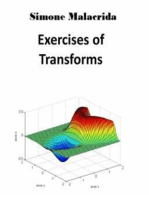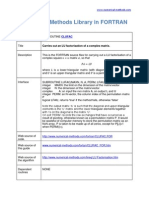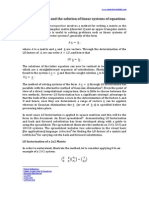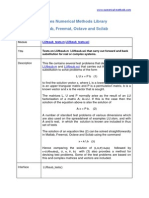Transfer Function Manipulation
Uploaded by
rodwellheadTransfer Function Manipulation
Uploaded by
rodwellheadwww.engineering.me.
uk
Transfer Function Manipulation
A typical control system is made up of components. Each component can be represented as a black box or block and can be represented by a transfer function 1. But blocks can be amalgamated together to be represented by a single block. Eventually the whole system can be represented by a single block. Blocks in series
It follows that
and
and hence that
That is if two blocks are in series then we can resolve the block into one block and the resultant transfer function is the product of the two component transfer functions.
TFM Exercise 1,2.
Feedback Loop The following diagram illustrates a typical control system block diagram with a feedback loop. The circle containing the cross represents a summing junction. The output is fed back through a control component at the summing junction the
Transfer Functions
www.engineering.me.uk
Note that
Substituting gives Multiplying out: Hence And
The equivalent one block system is given in the following diagram:
In the most straightforward case loop transfer function is
and
. In this case the closed
www.engineering.me.uk
Example1 Reconsider example 4 in the handout on transfer functions. Let us now introduce damping, as illustrated in the dashpot in example 3 of the same handout. The damping can be considered to be negative velocity feedback. Since the damping force is then the transfer function for the damping component is .
Hence the closed loop transfer function (CLTF) is
Remaining TFM Exercises.
www.engineering.me.uk
You might also like
- Mark Dorrian, Frédéric Poussin (Eds.) - Seeing From Above - The Aerial View in Visual Culture-I.B.Tauris (2013)No ratings yetMark Dorrian, Frédéric Poussin (Eds.) - Seeing From Above - The Aerial View in Visual Culture-I.B.Tauris (2013)337 pages
- Clinical Applications: Syngo Vessel ViewNo ratings yetClinical Applications: Syngo Vessel View8 pages
- Lecture 4 Mathematical Modelling of Transfer Functions (Autosaved)No ratings yetLecture 4 Mathematical Modelling of Transfer Functions (Autosaved)19 pages
- Lab Experiment 5: Block Diagram Reduction Objective100% (1)Lab Experiment 5: Block Diagram Reduction Objective7 pages
- Book Coverage: 5.1 - 5.2 HW: Problems: 5.4, 5.7, and 5.10No ratings yetBook Coverage: 5.1 - 5.2 HW: Problems: 5.4, 5.7, and 5.107 pages
- Antenna Azimuth Position Control System Verification100% (1)Antenna Azimuth Position Control System Verification4 pages
- LABVIEW Practice Problems Practice 1: Step 1: Define The Following Transfer FunctionsNo ratings yetLABVIEW Practice Problems Practice 1: Step 1: Define The Following Transfer Functions3 pages
- Lab 5: Block Diagram Reduction Objective: List of Equipment/SoftwareNo ratings yetLab 5: Block Diagram Reduction Objective: List of Equipment/Software7 pages
- LABVIEW Practice Problems Practice 1: Step 1: Define The Following Transfer FunctionsNo ratings yetLABVIEW Practice Problems Practice 1: Step 1: Define The Following Transfer Functions3 pages
- Study, Analysis and Evaluation of Block Diagram Reduction Name: University of Polytechnic/college ofNo ratings yetStudy, Analysis and Evaluation of Block Diagram Reduction Name: University of Polytechnic/college of10 pages
- Characteristics and Stability of Open Loop and Closed Loop Systems 1.aim of The ExperimentNo ratings yetCharacteristics and Stability of Open Loop and Closed Loop Systems 1.aim of The Experiment14 pages
- Transfer Function and Block Diagram of Control System Transfer FunctionNo ratings yetTransfer Function and Block Diagram of Control System Transfer Function8 pages
- Control Engineering: Closed-Loop Poles Are The Positions of The Poles (OrNo ratings yetControl Engineering: Closed-Loop Poles Are The Positions of The Poles (Or9 pages
- Slides 3: Reduction of Multiple SystemsNo ratings yetSlides 3: Reduction of Multiple Systems25 pages
- Transfer Function & Block Diagram Algebra: M. Azharul Haque Dept. of EEE PAUNo ratings yetTransfer Function & Block Diagram Algebra: M. Azharul Haque Dept. of EEE PAU69 pages
- Lecturer Two Summary Transfer Function of Physical SystemNo ratings yetLecturer Two Summary Transfer Function of Physical System5 pages
- Transfer Functions Block Diagrams Signal Flow Graph Mason's Gain Formula100% (1)Transfer Functions Block Diagrams Signal Flow Graph Mason's Gain Formula28 pages
- Representation of A Surface by Triangular PanelsNo ratings yetRepresentation of A Surface by Triangular Panels2 pages
- Numerical Methods Library in Excel VBA: Tests Code For 8-Point Gaussian Quadrature RuleNo ratings yetNumerical Methods Library in Excel VBA: Tests Code For 8-Point Gaussian Quadrature Rule1 page
- Condition Number of A Matrix - Excel Spreadsheet DemoNo ratings yetCondition Number of A Matrix - Excel Spreadsheet Demo4 pages
- Numerical Methods Library in FORTRAN: Test Code ForNo ratings yetNumerical Methods Library in FORTRAN: Test Code For2 pages
- LU Factorisation and Forward and Back Substitution - ExcelNo ratings yetLU Factorisation and Forward and Back Substitution - Excel4 pages
- Numerical Methods Library in FORTRAN: Sets The Weights and Points For The 8-Point Gaussian RuleNo ratings yetNumerical Methods Library in FORTRAN: Sets The Weights and Points For The 8-Point Gaussian Rule2 pages
- LUfbsub - Bas: Forward and Back Substitution in Visual BasicNo ratings yetLUfbsub - Bas: Forward and Back Substitution in Visual Basic2 pages
- M-Files Numerical Methods Library Matlab, Freemat, Octave and ScilabNo ratings yetM-Files Numerical Methods Library Matlab, Freemat, Octave and Scilab2 pages
- EDUC 3136 PSIII Chemistry PRACTICALS 2023 PDFNo ratings yetEDUC 3136 PSIII Chemistry PRACTICALS 2023 PDF80 pages
- A Robust Torque and Drag Analysis Approach For Well Planning and Drillstring Design100% (1)A Robust Torque and Drag Analysis Approach For Well Planning and Drillstring Design16 pages
- Characteristics of Different Breeds Involved in Development of Broilers & LayersNo ratings yetCharacteristics of Different Breeds Involved in Development of Broilers & Layers20 pages
- Anatomy & Physiology of Respiratory SystemNo ratings yetAnatomy & Physiology of Respiratory System37 pages
- Gadgets For Management of Stored Products InsectsNo ratings yetGadgets For Management of Stored Products Insects48 pages
- Comparison of The ASME, BS and CEN Fatigue Design Rules For Pressure Vessels (October 2003)No ratings yetComparison of The ASME, BS and CEN Fatigue Design Rules For Pressure Vessels (October 2003)2 pages
- TN223260 20180423T130036 Staff Analysis of Air Filter Pressure Drop and Air Filter SizinNo ratings yetTN223260 20180423T130036 Staff Analysis of Air Filter Pressure Drop and Air Filter Sizin11 pages
- Engineers Handbook of Industrial Microwave Heating Industrial Microwave Oven Manufacturers Large Microwaves PDF100% (1)Engineers Handbook of Industrial Microwave Heating Industrial Microwave Oven Manufacturers Large Microwaves PDF9 pages
- Singer 591D200, D300, C200, C300 Operator's GuideNo ratings yetSinger 591D200, D300, C200, C300 Operator's Guide19 pages
- Mark Dorrian, Frédéric Poussin (Eds.) - Seeing From Above - The Aerial View in Visual Culture-I.B.Tauris (2013)Mark Dorrian, Frédéric Poussin (Eds.) - Seeing From Above - The Aerial View in Visual Culture-I.B.Tauris (2013)
- Lecture 4 Mathematical Modelling of Transfer Functions (Autosaved)Lecture 4 Mathematical Modelling of Transfer Functions (Autosaved)
- Lab Experiment 5: Block Diagram Reduction ObjectiveLab Experiment 5: Block Diagram Reduction Objective
- Book Coverage: 5.1 - 5.2 HW: Problems: 5.4, 5.7, and 5.10Book Coverage: 5.1 - 5.2 HW: Problems: 5.4, 5.7, and 5.10
- Antenna Azimuth Position Control System VerificationAntenna Azimuth Position Control System Verification
- LABVIEW Practice Problems Practice 1: Step 1: Define The Following Transfer FunctionsLABVIEW Practice Problems Practice 1: Step 1: Define The Following Transfer Functions
- Lab 5: Block Diagram Reduction Objective: List of Equipment/SoftwareLab 5: Block Diagram Reduction Objective: List of Equipment/Software
- LABVIEW Practice Problems Practice 1: Step 1: Define The Following Transfer FunctionsLABVIEW Practice Problems Practice 1: Step 1: Define The Following Transfer Functions
- Study, Analysis and Evaluation of Block Diagram Reduction Name: University of Polytechnic/college ofStudy, Analysis and Evaluation of Block Diagram Reduction Name: University of Polytechnic/college of
- Characteristics and Stability of Open Loop and Closed Loop Systems 1.aim of The ExperimentCharacteristics and Stability of Open Loop and Closed Loop Systems 1.aim of The Experiment
- Transfer Function and Block Diagram of Control System Transfer FunctionTransfer Function and Block Diagram of Control System Transfer Function
- Control Engineering: Closed-Loop Poles Are The Positions of The Poles (OrControl Engineering: Closed-Loop Poles Are The Positions of The Poles (Or
- Transfer Function & Block Diagram Algebra: M. Azharul Haque Dept. of EEE PAUTransfer Function & Block Diagram Algebra: M. Azharul Haque Dept. of EEE PAU
- Lecturer Two Summary Transfer Function of Physical SystemLecturer Two Summary Transfer Function of Physical System
- Transfer Functions Block Diagrams Signal Flow Graph Mason's Gain FormulaTransfer Functions Block Diagrams Signal Flow Graph Mason's Gain Formula
- Finite-Time Stability: An Input-Output ApproachFrom EverandFinite-Time Stability: An Input-Output Approach
- Numerical Methods Library in Excel VBA: Tests Code For 8-Point Gaussian Quadrature RuleNumerical Methods Library in Excel VBA: Tests Code For 8-Point Gaussian Quadrature Rule
- Condition Number of A Matrix - Excel Spreadsheet DemoCondition Number of A Matrix - Excel Spreadsheet Demo
- Numerical Methods Library in FORTRAN: Test Code ForNumerical Methods Library in FORTRAN: Test Code For
- LU Factorisation and Forward and Back Substitution - ExcelLU Factorisation and Forward and Back Substitution - Excel
- Numerical Methods Library in FORTRAN: Sets The Weights and Points For The 8-Point Gaussian RuleNumerical Methods Library in FORTRAN: Sets The Weights and Points For The 8-Point Gaussian Rule
- LUfbsub - Bas: Forward and Back Substitution in Visual BasicLUfbsub - Bas: Forward and Back Substitution in Visual Basic
- M-Files Numerical Methods Library Matlab, Freemat, Octave and ScilabM-Files Numerical Methods Library Matlab, Freemat, Octave and Scilab
- A Robust Torque and Drag Analysis Approach For Well Planning and Drillstring DesignA Robust Torque and Drag Analysis Approach For Well Planning and Drillstring Design
- Characteristics of Different Breeds Involved in Development of Broilers & LayersCharacteristics of Different Breeds Involved in Development of Broilers & Layers
- Comparison of The ASME, BS and CEN Fatigue Design Rules For Pressure Vessels (October 2003)Comparison of The ASME, BS and CEN Fatigue Design Rules For Pressure Vessels (October 2003)
- TN223260 20180423T130036 Staff Analysis of Air Filter Pressure Drop and Air Filter SizinTN223260 20180423T130036 Staff Analysis of Air Filter Pressure Drop and Air Filter Sizin
- Engineers Handbook of Industrial Microwave Heating Industrial Microwave Oven Manufacturers Large Microwaves PDFEngineers Handbook of Industrial Microwave Heating Industrial Microwave Oven Manufacturers Large Microwaves PDF












































































































